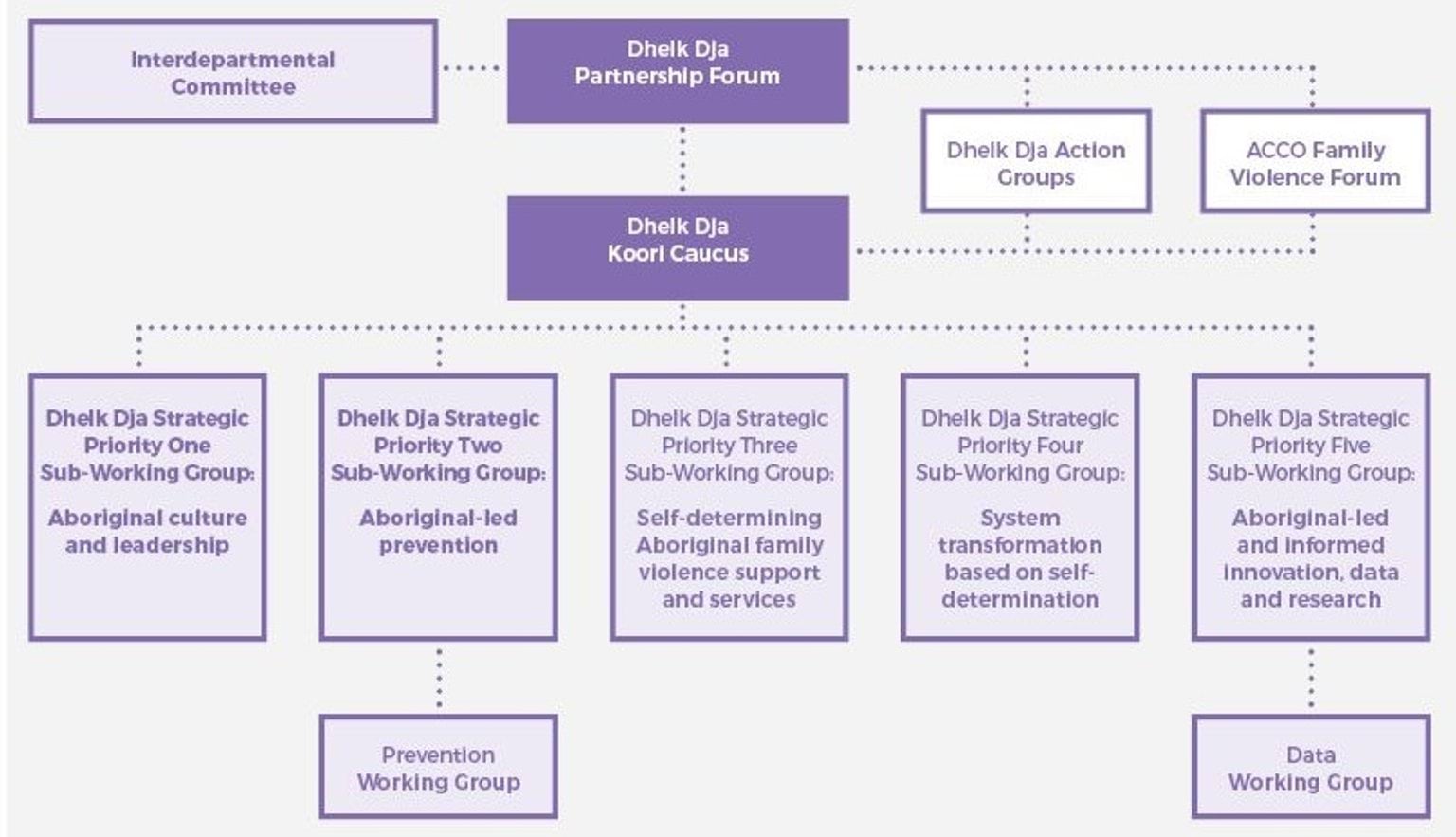The Royal Commission into Family Violence acknowledged the high rates and devastating impacts of family violence within Aboriginal communities. It also found that the:
... full potential of Aboriginal community controlled organisations to prevent and respond to family violence has not been realised.
In making this finding, the Royal Commission referenced the strong policy foundations provided by the [then] Strong Culture, Strong Peoples, Strong Families: Towards a Safer Future for Indigenous Families and Communities 10-Year Plan 2008–2018 (the predecessor to the Dhelk Dja 10-year agreement) and the work of the Indigenous Family Violence Task Force. It also identified factors that had impeded progress including:
- a lack of funding and short-term funding undermining efforts – particularly for prevention and early intervention
- insufficient investment in evaluation to better target efforts
- inadequate data collection by mainstream (i.e. non-Aboriginal-led) agencies to inform Aboriginal-led efforts
- a need to ensure Aboriginal people can choose whether to access Aboriginal or mainstream services and to ensure ACCOs are able to support Aboriginal communities.
The Royal Commission recognised that in working to address family violence:
… it is crucial to understand family violence as emerging within the context of deep intergenerational trauma as a result of colonisation, dispossession and the destructive impact of policies and practices such as the forced removal of children. There is no doubt that for Aboriginal and Torres Strait Islander peoples, culture is the foundation upon which everything else is built and that strong cultural identity and connection is key to better outcomes.
The Royal Commission made several recommendations that relate to primary prevention and early intervention in Aboriginal communities.1 These recommendations included the need for government to:
- implement recommendations of the mid-term evaluation of the Indigenous Family Violence 10-Year Plan, which included establishing an additional stream of ongoing funding to support family violence responses in Aboriginal communities (including the continuation of initiatives tested through the Community Initiatives Fund)
- provide adequate funding to ACCOs for (among other things) early intervention and prevention efforts, including ‘whole-of-community activities and targeted programs’
- ensure family violence awareness and prevention campaigns reflect the diversity of the Victorian population, including Aboriginal Victorians, and are developed in close consultation with communities
- develop a strategic approach to ‘improving the lives of vulnerable Aboriginal children and young people’ in partnership with Aboriginal communities
- improve the collection and sharing of Aboriginal-specific data in the family violence area by government for use by Aboriginal communities, organisations and governance forums to inform responses at the local, regional and statewide levels
- employ evaluation models that use culturally appropriate measures and methodologies, and support to ensure Aboriginal service providers have the capacity to support culturally appropriate evaluations within their organisations.
Since then, government’s approach to implementing these recommendations has been set out through a considerable number of plans, strategies and commitments (see Figure 4). For example (in order of release date):
- Ending Family Violence: Victoria’s Plan for Change (2016) commits to:
- delivering a dedicated prevention agency
- a statewide primary prevention strategy
- a complementary 10-year Aboriginal family violence plan
- strengthening the operation of the Indigenous Family Violence Partnership Forum (now the Dhelk Dja Partnership Forum).
- Free From Violence: Victoria’s Strategy to Prevent Family Violence and all Forms of Violence Against Women (2017) acknowledges that preventing family violence against Aboriginal people and their communities requires community-led, holistic healing approaches and ‘addressing the drivers of violence that lead to institutional discrimination and racism’. The strategy is being implemented through a series of action plans, which include specific commitments for prevention efforts in Aboriginal communities:
- Free From Violence – First Action Plan 2018–2021 committed to a major behaviour change campaign with a specific focus on preventing family violence for Aboriginal people;2 and supporting the development and trialling of new approaches to prevention led by Aboriginal communities, including providing funding for workforce capacity building.
- Free From Violence – Second Action Plan 2022–2025 reiterates a commitment to self-determination and outlines five actions aligned with Dhelk Dja (see below).
- Building From Strength: 10-Year Industry Plan for Family Violence Prevention and Response (2017) outlines a high-level vision of a highly skilled prevention workforce that strengthens the ability of the system to address the drivers of all forms of family violence and work at the population level. The industry plan included an immediate action to pilot ‘a model of embedding primary prevention expertise to work with the LGBTI, seniors and Aboriginal sectors to build primary prevention capacity and capability’.
- Dhelk Dja: Safe Our Way – Strong Culture, Strong Peoples, Strong Families Agreement 2018–2028 is the guiding strategy and principal agreement between the Victorian Government and Aboriginal communities to address family violence. The agreement sets out five strategic priorities to be progressed through three successive action plans and assessed through a monitoring, evaluation and accountability plan. Strategic priority 2 is Aboriginal-led prevention and outlines a vision that ‘all prevention and early intervention initiatives will be led by Aboriginal communities and based on their choices and their solutions’.
- Dhelk Dja 3 Year Action Plan 2019–2022 is the first of the action plans and sets out two critical actions and seven supporting activities to be delivered under priority 2: Aboriginal-led prevention, including:
- mapping Aboriginal-specific primary prevention initiatives and investment
- showcasing successful initiatives to share best practice
- reviewing and updating the Indigenous Family Violence Primary Prevention Framework (2012)
- developing and delivering a prevention campaign and education program for Aboriginal communities
- sustainable investment for successful Aboriginal-led prevention initiatives
- ensuring initiatives to prevent family violence address racism and discrimination against Aboriginal people as drivers of family violence.
- Dhelk Dja 3 Year Action Plan 2019–2022 is the first of the action plans and sets out two critical actions and seven supporting activities to be delivered under priority 2: Aboriginal-led prevention, including:
- Wungurilwil Gapgapduir: Aboriginal Children and Families Agreement (2018) is a partnership between Aboriginal communities, government and community services organisations. It commits to a strategic approach to improving outcomes for Aboriginal children and young people and was developed in response to recommendation 145 of the Royal Commission.
- Nargneit Birrang – Aboriginal Holistic Healing Framework for Family Violence (2019) establishes a shared understanding of holistic healing for Aboriginal communities to guide the delivery and evaluation of Aboriginal-led holistic healing programs for family violence in Victoria. It was developed through an Aboriginal-led, co-design process with Aboriginal communities.
There are also several related government strategies and agreements that are not specific to family violence prevention and early intervention but relate to the wellbeing of Aboriginal people, families and communities more broadly and intersect with family violence prevention activity:
- Aboriginal Justice Agreement is a long-term partnership between Aboriginal communities and the Victorian Government that seeks to improve justice outcomes for Aboriginal people. Prevention and early intervention of family violence are identified under Outcome Domain 1 of Burra Lotjpa Dunguludja (Aboriginal Justice Agreement Phase 4) – Strong and safe Aboriginal families and communities.
- Balit Murrup: Aboriginal Social and Emotional Wellbeing Framework 2017–2027 is a framework forming part of the Victorian Government’s commitment to improving the social and emotional wellbeing and mental health outcomes for Aboriginal communities. In Domain 2 of the framework – Supporting resilience, healing and trauma recovery – actions relating to improving connection to community, cultural strengthening and will intersect with family violence prevention activity.
- Korin Korin Balit-Djak: Aboriginal Health, Wellbeing and Safety Strategic Plan 2017–2027 is an overarching framework to improve the health, wellbeing and safety of Aboriginal Victorians. Increasing access to Aboriginal community-led family violence prevention and support services is a priority under Guiding Principle 4 of the framework – Safe, secure and strong families and individuals.
- Closing the Gap Partnership Agreement (2019–2029) is the national agreement between the Commonwealth, state and territory governments and Aboriginal and Torres Strait Islander peak organisations committing to action to closing the gap in life outcomes between Indigenous and non-Indigenous Australians across 17 socioeconomic areas. The Victorian Closing the Gap Implementation Plan 2021–23 outlines how Victoria will meet its Closing the Gap commitments, including reducing the rate of all forms of family violence and abuse against Aboriginal women and children by at least 50 per cent.
- The Royal Commission into Victoria’s Mental Health System interim (2019) and final reports (2021) identified the urgent need to address mental illness in Aboriginal communities and the central role of self-determined Aboriginal social and emotional wellbeing services in promoting Aboriginal social and emotional wellbeing.
- Mana-na woorn-tyeen maar-takoort (every Aboriginal person has a home): Victorian Aboriginal Housing and Homelessness Framework (2020) aims to address homelessness and improve housing for Aboriginal Victorians. It recognises that those experiencing or using family violence are at a higher risk and therefore need specialist and intensive housing, community support and pathways.
- Victorian Aboriginal Affairs Framework 2018–2023 is the Victorian Government's overarching framework for working with Aboriginal Victorians, organisations and the wider community to drive action and improve outcomes. It commits government to reduce the incidence and impact of family violence affecting Aboriginal families (objective 3.1), with the goal being for Aboriginal families and households to thrive. It also sets out the whole-of-Victorian-Government self-determination enablers and principles and commits government to significant structural and systemic transformation.
Guiding primary prevention efforts are two specific frameworks for Aboriginal family violence prevention – one Victorian and the other national:
- Indigenous Family Violence Primary Prevention Framework (2012) predates the Royal Commission. The framework’s development was led by the Dhelk Dja Action Groups formerly known as the Indigenous Family Violence Regional Action Groups. It identifies best practice features of primary prevention in Aboriginal communities and was designed to support prevention capacity building in Victoria. A refresh of the framework is a key commitment under the first Dhelk Dja Action Plan and Victoria’s Closing the Gap implementation plan and was due for completion by December 2021. At the time of writing, the refresh of the framework was in the early stages of planning.
- Changing the Picture (2018) was developed by Our Watch and provides a specific national framework to drive the prevention of violence against Aboriginal women and their children across Australia; it sits alongside the overarching Change the Story framework and resources. It includes specific actions needed to address the complex drivers of violence against Aboriginal women and their children.
A timeline of key strategies, plans and agreements is provided as Figure 4.
A number of governance mechanisms have been established to guide and oversee family violence prevention and early intervention effort in Aboriginal communities in Victoria, and these are outlined in Box 1. The Dhelk Dja governance structure is presented in Figure 5.
Box 1: Governance of family violence prevention and early intervention in Aboriginal communities
The Dhelk Dja Partnership Forum leads the strategic work to implement the Dhelk Dja: Safe Our Way – Strong Culture, Strong Peoples, Strong Families 2018-2028 agreement and subsequent rolling action plans, with the guiding principle of self-determination. Membership comprises the chairpersons of the 11 Dhelk Dja Regional Action Groups, CEOs of family violence funded ACCOs and representatives from relevant Victorian government departments.
The Dhelk Dja Strategic Priority Two Sub-Working Group: Aboriginal-led Prevention is a working group of the Dhelk Dja Partnership Forum that leads and oversees the work under Strategic Priority Two of Dhelk Dja: Safe Our Way. The group is co-led by a nominated member of the Koori Caucus and Family Safety Victoria’s Aboriginal Strategy Unit. The group meets quarterly, and membership is open to any member of the Dhelk Dja Partnership Forum.
The ACCO Family Violence Sector Forum sits under the Dhelk Dja governance structure and is currently co-chaired by the CEO of the VACCA and the director of the Centre for Workforce Excellence Unit, Family Safety Victoria. It brings together the CEOs of all family violence funded ACCOs, Dhelk Dja regional coordinators and government representatives from Family Safety Victoria and the Department of Families, Fairness and Housing to ensure all family violence services and responses for Aboriginal people are developed in a culturally safe way.
The Primary Prevention Sector Reference Group supports the government’s accountability for the broader family violence primary prevention reforms, under the 10-year Free from Violence strategy. This advisory group meets quarterly and provides strategic advice to the Victorian Government on any current and emerging issues for the implementation of the reforms. Membership comprises Victorian Government departments and non-government agencies whose core business includes primary prevention of family violence, including those that have specific expertise in Aboriginal self-determination.
The Partnership Forum on Closing the Gap Implementation is a time-limited forum, being set up to partner with the government in the decision-making process surrounding the implementation of the National Agreement on Closing the Gap, consistent with Victoria’s Closing the Gap Implementation Plan. Membership will comprise an ACCO representative from each sector that covers the National Agreement targets and action areas, Aboriginal governance forum delegates and senior departmental executives from all Victorian Government departments. The forum will operate until 2023, when the implementation plan is to be reviewed.
Footnotes
- We identified four Royal Commission recommendations that relate specifically to primary prevention and early intervention within Aboriginal communities: recommendations 142, 144, 187, 189; and seven recommendations that are broader in focus but are relevant to Aboriginal prevention and early intervention: recommendations 142, 145, 146, 147, 152, 187, 189.
- Noting that the behaviour change campaign with a specific focus on preventing family violence for Aboriginal people has been postponed to the second action plan 2022–2025.
Updated



